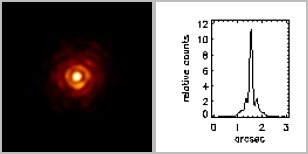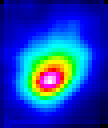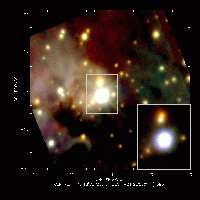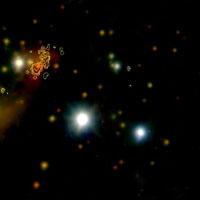
by Stefan Hippler, Ric Davies, and Markus Feldt***
The Calar Alto Observatory adaptive optics (AO) system with a laser guide star (LGS) facility, called ALFA, is currently being used on the CAHA 3.5m telescope. ALFA has now seen three years of operation on the telescope. The instrument had first light in September 1996 and was in parallel used for science observations and for continuous improvements and optimisations during approx. 200 nights. ALFA's first year on the telescope with 60 scheduled nights was a commissioning only year. The performance of the AO system at the end of that first year was as follows: We achieved diffraction limited cores (0.13'') of the point-spread functions (PSF) in K-band with maximum Strehl numbers of 20% (see results of observations of 14 Peg with ALFA and MAGIC in July 1997).
At the end of 1997, fifteen months after first light, ALFA closed the high order AO loop on the LGS for the first time. The spatial resolution of the observed object BD +31 643 was improved by a factor of 2 from 1.2'' full width at half maximum (FWHM) to 0.56'' FWHM (see also ALFA press release January 1998).
Another 9 months later, in summer 1998 ALFA achieved its first goal: Strehl numbers >60% in K-band with natural guide stars of 8th magnitude in V-band (best result of ALFA so far is 72% Strehl in K-band). In J-band ALFA achieved 12% Strehl and FWHMs below 0.1''. The first efforts in August 1998 at using the LGS while observing an extragalactic object, UGC 1347, produced a slightly flawed PSF, but subsequent attempts have been significantly better. Observations of NGC 6764 (May 1999) showed that in seeing of nearly 1" the LGS improved the resolution to little more than 0.5" without any assistance from tip-tilt.
Finally, in June 1999 ALFA reached its major goal: diffraction limited images with the sodium-layer LGS in K-band, achieving a Strehl ratio of 23% (Hippler et al. 1999, Butler et al. 1999, Davies et al. 2000).
 |
The figures above show an image and profile of the PSF in open loop, with just the tip-tilt loop closed, and also with the high orders corrected using the LGS (the full 200sec integration, and the best 10sec). To put this into perspective, we should consider the wavefront error, which was reduced by 1.3 rad2. The only other result like this was when Lick Observatory recently reached a Strehl ratio of 42% in seeing of 0.5", reducing the wavefront error by 1.4 rad2 (Olivier et al. 1999). These results from Lick and ALFA are by far the best that anyone has achieved with a sodium laser guide star.
The efforts that led to these final (June 1999) performance characteristics are described in various papers. Another 65 (of the 200) scheduled nights reserved for optimisation purposes were necessary to reach this superior performance. A summary of the current ALFA performance is shown in table 1.
During these almost 3 years of commissioning and optimisation of the AO and the LGS system about 60 nights of science observations with ALFA were scheduled. 25 of these were indeed useful and yielded very good and excellent results. A good example of what ALFA can achieve with natural guide stars is the observation of the Lagoon nebula (M8). Further results can be found on the ALFA homepage.
ALFA is a common user instrument and was made available to the astronomical community from August 1998. Two fully qualified ALFA operators (L. Montoya and J. Aceituno) assist the observers during their observing runs.
Another 15 nights were used for training, setup, Scidar and Lidar observations with ALFA. All 200 nights, which reduce to about only 80 useful nights for an AO system with a Laser Guide Star facility (due to weather, seeing, and atmospheric transparency statistics), were absolutely worthwhile spending: ALFA now produces routinely diffraction limited images and spectra in K-band with natural guide stars as faint as mR=11. Nearly diffraction limited data can be obtained with natural reference sources as faint as V=13.5 mag. This is typically an improvement in spatial resolution of the 3.5-m telescope by a factor of 6!
The situation looks slightly different for AO observations with the Laser Guide Star. As a proof of principle ALFA has shown that AO observations with the LGS can result in diffraction limited images in K-band. However, the overhead time of ALFA in combination with the LGS is still high (about 40%, i.e. almost as much time is spent for laser and AO operation as for scientific observations) but what matters most are the strong requirements on the environmental conditions in order to use the full ALFA system. One solution to overcome these restrictions is flexible scheduling in combination with service observations. This has been tried in the summer semester 1999 on the 3.5-m telescope with good success.
Science with ALFA
Although results obtained during technical time can show ALFA's capabilities when everything is going well, the best way to see what ALFA can do is to look at results from actual science observing. The examples presented here were obtained during a few nights during September/October 1999.
One of the most exciting possibilities for adaptive optics is integral field spectroscopy at the diffraction limit. ALFA and MPE's 3D instrument have previously demonstrated this capability by obtaining spectra of the two components of HEI 7, a 0.26" separation binary (Davies et al. 1999). In this contribution we present some more recent observations to show what is possible; for further information (which will be updated as it becomes available) follow the links.
| All the images here except NGC 1161 are about 1" across |  |
 |
 |
|
Of course one of the most natural applications for AO is plain imaging at very high resolution. Determining the morphology of complex targets with resolutions comparable to those of radio interferometers and space telescopes, not only yields impressive images but also enables the accurate photometric determination of physical properties . In this way, it is possible for example, to determine the stellar content, the ionisation characteristics, and the extinction distribution of massive star forming regions. This is shown in the following two examples:
 |
 |
| The Lagoon Nebula | G77.965-0.006 |
The Lagoon Nebula is a region of ongoing star formation around the massive star Her 36. It is located at distance of 1.5 kpc.
G77.965-0.006 is an ultra compact HII region originally classified as irregular by Kurtz, Churchwell, and Wood.
Outlook
The irony of adaptive optics is that the better the seeing, the better the AO performance; and in seeing worse than 1.5" no AO system anywhere can help much. What does this mean for the observer? Consider a V=13 mag star. If you want a good correction with 18 subapertures sampled at 300Hz, there will be fewer than 150 photons available for each centroid measurement on the wavefront sensor; it is simply not possible to measure the centroid accurately. With only 6 subapertures at 100Hz there will be 10 times more photons; you can measure the centroid well, but the correction is limited. So even though ALFA is now working close to its theoretical limit, it is only possible to get a good correction on faint stars in good conditions.
Fortunately for brighter stars the performance improves dramatically, and very good corrections can normally be obtained with stars brighter than V=11. Additionally, Calar Alto is one of only 2 observatories to have a sodium guide star facility. Together with a new tip-tilt tracker (to be installed in the spring, making stars at least as faint as V=16 useful), this opens up a huge area of sky for AO observations. Particularly in the next year or two, before LGS/AO systems begin to appear at other observatories, the potential for observers at Calar Alto is huge.
ALFA has shown that it can perform really well, achieving:
It's up to you to use it.
Acknowledgements.
The authors are grateful to all the people who have helped to obtain the results presented here. In particular they thank: ALFA team (A.Eckart, T.Ott, M.Kasper, W.Hackenberg, R.-R.Rohloff, D.Butler, K.Wagner, R.Weiss, J.Aceituno, L.Montoya), 3D team (L.E.Tacconi-Garman, N.Thatte, F.Eisenhauer, S. Anders, M.Tecza) and others (L. Looney).
| Guide Star | Seeing in V [ ''] |
Sub- apertures |
Loop Band- width [Hz] |
Corrected FWHM [ ''] |
Corrected Strehl [%] |
Loop Robustness |
| Bright NGS mV <= 8 |
1.3-1.8 0.9-1.2 |
30 30 |
30 - 90 30 - 90 |
<= 0.2 0.14 |
~ 25 ~ 50 |
++ ++ |
| Faint NGS mV ~ 9-11 |
1.3-1.8 0.9-1.2 |
18 30, 18 |
10 - 20 10 - 20 |
<= 0.2 ~ 0.15 |
~ 15 ~ 30 |
++ ++ |
| Very faint NGS mV >= 12 |
1.3-1.8 0.9-1.2 |
6 18, 6 |
6 - 10 6 - 15 |
? ~ 0.2 |
? ~ 15 |
? + |
| LGS mV ~ 10 |
1.3-1.8 0.9-1.2 |
6 18 |
6 6 - 10 |
? <= 0.25 |
? 10-15 |
- ± |
| Lick LGS mV ~ 7 |
0.8 | 37 | 30 | 0.3 | 9.1 | ? |
| ESO ADONIS mV = 13 |
< 1 | 32 | 10 | 0.3 | 9 | ++ |
The ALFA pages have a full list of ALFA publications.
Max, C.E., Olivier, S.S., Friedman, H.W., An, J., Avicola, K., Beeman, B.V., Bissinger, H.D., Brase, J.M., Erbert, G.V., Gavel, D.T., Kanz, K., Liu, M.C., Macintosh, B., Neeb, K.P., Patience, J., Waltjen, K.E., Image improvement from a sodium-layer laser guide star adaptive optics system, Science 277, 1649 (1997)
Le Mignant, D., Marchis, F., Bonaccini, D., Prado, P., Barrios, E., Tighe, R., Merino, V., Sanchez, A., The ESO/ADONIS system: a 3 years experience in observing methods, ESO proceedings 56, 287 (1999)
ALFA: Wavefront Sensing with Natural and Laser Guide Stars, Hippler, S., Feldt, M., Kasper, M., Davies, R., Glindemann, A., in Proceedings of the Canterbury Conference on Wavefront sensing and its applications, Canterbury 1999 (http://speke.ukc.ac.uk/physical-sciences/main/School/submit.htm).
Calar Alto ALFA and the sodium laser guide star in Astronomy, Butler D., Davies R., Fews H., Hackenberg W., Rabien S., Ott T., Eckart A., Kasper M., 1999 in Adaptive Optics Systems and Technology, eds Tyson & Fugate, SPIE, vol. 3762, p. 184
First Observational Results from ALFA with Natural and Laser Guide Stars, Davies R., Hackenberg W., Ott T., Eckart A., Rabien S., Anders S., Hippler S., Kasper M., 1999 in Astronomy with Adaptive Optics, ed Bonaccini, ESO Proc. 56, p. 153
The ALFA Laser Guide Star: Operation and Results, Davies R., Eckart A., Hackenberg W., Ott, T., Butler D., Kasper M., Quirrenbach A., 2000 Experimental Astronomy, in press
Improved performance of the laser guide star adaptive optics system at Lick Observatory, Olivier S., Gavel D., Friedman H., Max C., An J, et al., 1999, in Adaptive Optics Systems and Technology, eds Tyson & Fugate, SPIE, vol. 3762, p. 2